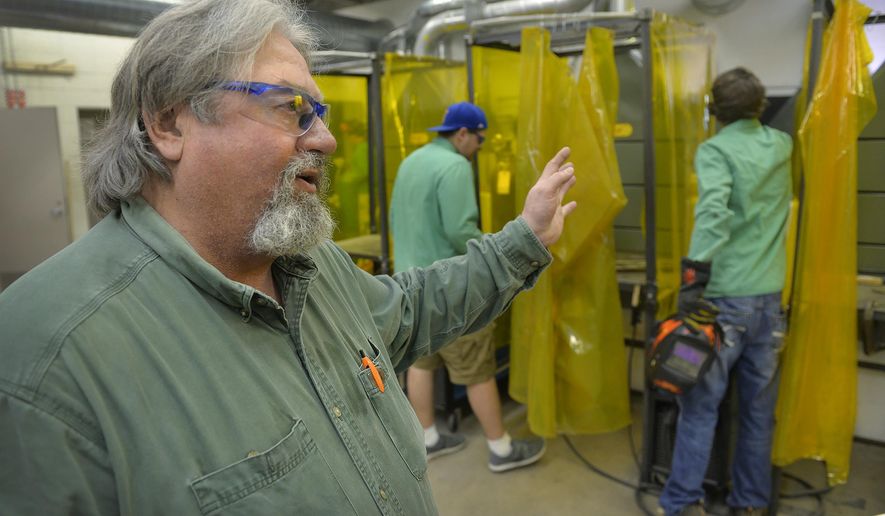KIMBALL, Minn. (AP) - They may just be traditional high school kids, talking about writing essays for an English class, complaining about their math homework and getting ready for the weekend.
But once they set foot inside the welding and woodworking shop at Kimball High School, it’s time for business, SCTimes (https://on.sctimes.com/2c8aYyb ) reported.
Donning heavy dark green jackets, thick yellow leather gloves and full-faced welding helmets, not much other than experience separates Tracy Nelson’s basic and advanced welding students from the professionals.
“You have to learn different types of welds,” said Cole Czech, 18. “And we have to display our understanding of those welds.”
The 18-year-old, who graduated in May, plans on taking some of his knowledge with him as he starts his first semester at the University of North Dakota in the aeronautical engineering program.
“It doesn’t matter what field you’re interested in,” Czech said. “It’s good to have the general know-how.”
Cramped into a small portion of the shop are several styles of welders where students have to display proficiency by successfully completing 75 welds during the course. Each student has to have experience doing wire welding, arc (or stick) welding and oxy-acetylene welding.
Wire welding, a standard procedure in industry, involves using a thin wire that is fed constantly as the two pieces of metal are heated. The thin metal creates a bond, or a weld, that holds the two pieces together. Arc or stick welding swaps out the thin wire for a metal rod to make a stronger and thicker weld. Oxy-acetylene welding uses a gas mixture of oxygen and acetylene to create a flame that is capable of melting the two metals together.
“We have about 16 to 20 students in the class,” said A.J. Lerum, Kimball High School’s 2016-2015 interim agricultural instructor. “We always have a rotation of students doing some welding and some preparation.”
The metal used at Kimball High School is donated scrap metal from a local company.
Nelson’s course takes in students with all levels of welding experience. The course is an elective available from freshman year on up.
“We want a little bit more mature students,” Lerum said. “Especially since there is only one instructor.”
Lerum said at the beginning of the class students learn how welding work and how to properly prepare the metal.They watch demonstrations to learn how to make the proper welds.
“You have to know the (composition) of the metal,” Lerum said. “You have to get the welder set right. You have to know how thick the weld can be.”
Kimball High School students are not just learning the basics of welding. They are learning how to weld up to industry standards.
“We partner with St. Cloud Technical & Community College so when students go up there they get college credit,” Lerum said.
Nelson’s welding courses provide students with one college credit.
It’s something her student, Jacob Lindberg, 15, appreciates.
Lindberg, a junior now, said he decided to take Nelson’s welding class last year because of his dad.
“My dad owned a little (welding) shop,” Lindberg said. “And I would always go with him down to the shop. I sat there for hours watching him. And one day he wanted to me to try it. And I’ve been welding ever since.”
Lindberg admits the course was pretty easy for him. But he said the knowledge will help him down the road.
“I don’t know what I really want to do yet. I could be a mechanic or a welder, both are good careers. But welding is a good skill to learn,” he said.
Fellow classmate Kade Reddemann, 16, came into Nelson’s class with little welding experience.
A junior now, Reddemann said friends influenced him to take welding last spring.
But for him, welding has sparked a new hobby for him. Especially when it comes to stick welding.
“It’s like melting butter on a piece of metal,” he said. “It takes a lot of practice and a lot of patience. If you go too fast it’s not good. If you go too slow it’s not good either.”
Reddemann said he spent most of his after-school free time in the shop working on welds. And that work paid off.
“I was one of three students to get extra credit on a weld,” he said.
Lerum knows that not all of the students taking basic or advanced welding will become welders or going into the welding field. But what he does know is that students taking Nelson’s course are excited to learn and challenge themselves with this very hands-on class.
“The students enjoy doing this,” he said. “And they know there is opportunity for employment (in this field).”
___
Information from: St. Cloud Times, https://www.sctimes.com




Please read our comment policy before commenting.